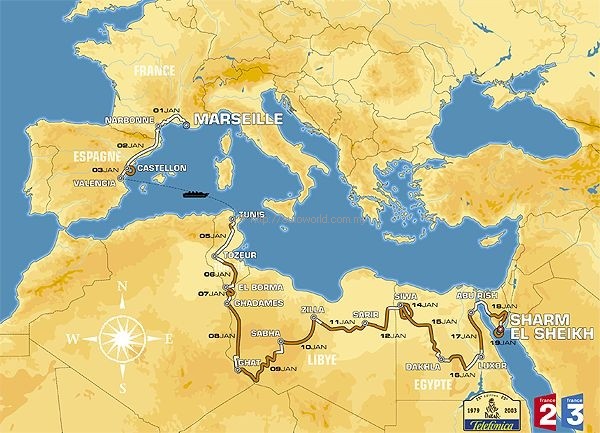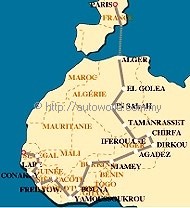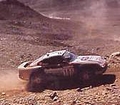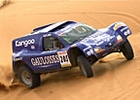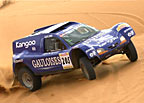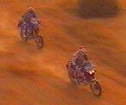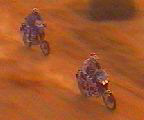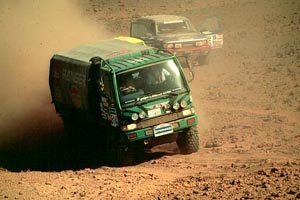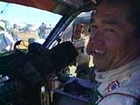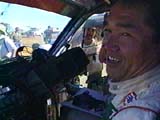Dakar – the ‘world cup’ of cross-country rallying
Events like the Paris-Peking Rally, (1907), London-Sydney (1968) or London-Mexico (1970) are among the pinnacles of motorsport history as single events, but the history of modern-day cross country rallying starts only in 1979.
In that year, Frenchman Thierry Sabine organised the Paris-Dakar rally for the first time. It was a 10,000 km long motoring adventure through France, Algeria, Niger, Mali and Upper-Volta to end in Senegal. On that inaugural event, 170 privateers took the challenge of the first desert rally using mostly production models of off-road cars and motorcycles. For example, in the first year, a Range Rover – acknowledged as the supreme off-roader in those days – was the winner. In the years to follow, some exotic cars would be specially developed for the event by Porsche, Citroen, Renault and Peugeot.
What began as a loose range of various events in the Mediterranean and northern-African area turned into a series of cross-country rallies in the 1990s, receiving “world cup” accolades from motorsport’s governing body, the FIA.
However, the Dakar Rally, traditionally the opening round of the cross-country season in January, has no longer been part of the ‘world cup’ since 2002. As of this year, the most outstanding single event on the calendar – with almost 20 days of competition and a distance of some 10,000 kilometres also by far the most demanding – has regulations that slightly differ from the FIA rules. Nevertheless, the Dakar is the most popular of all cross-country events, attracting several hundreds of competitors in the categories cars, motorcycles and even trucks (usually for support) every year.
In its 25-year history, the category has been clearly separated from traditional rallying (typified by the WRC), both in technical aspects and in competition. For instance, the rough conditions of cross-country rallying require the use of all-terrain vehicles, ranging from traditional off-road cars to exotic 4WD prototypes. As from the start of the 2002 season, clever technical regulations divide the cars in the T1 category for standard off-road cars and T2 for prototype vehicles of all kinds.
Regulations seek to level the differences between the various concepts in the aspects of engine (atmospheric vs. turbocharged engines, petrol or diesel engines, differences in displacement) and transmission (two or 4-wheel drive) by various restrictions, weight limits and other factors.
The endurance character is another major difference separating cross country-events from sprint rallies. In the WRC, the competitive itinerary usually covers 400 kms, whereas the minimum in cross-country rallying has been set at 450 kms for Baja-type events. Usually, such events cover between 1,200 and 6,500 kms over as many as 10 days. With almost three weeks of competition, the Dakar Rally thus has held a special status.
Since the prototype regulations have come into force at the beginning of 2002, this fascinating type of motorsport is flourishing. Since this year, major car manufacturers have been committed to cross-country rallying more strongly or even for the first time with factory-supported teams or with full works-efforts. VW’s entry in the 2003 event is an example of this motivation.
While all previous Dakar rallies have run from north (France) to south – usually in west Africa – the 2003 event runs along north Africa. 437 competitors (comprising 155 motorcycles, 124 cars, 45 trucks and 113 assistance vehicles) will race across Libya, Tunisia and Egypt, covering 8,552 kms to cross the Suez Canal zone and end in Sharm-el-Sheikh on the tip of the Sinai Peninsula after 19 days.
Dakar Rally Winners – 1979 ~ 2002
2002 MASUOKA / MAIMON (Mitsubishi)
2001 KLEINSCHMIDT / SCHULZ (Mitsubishi)
2000 SCHLESSER / MAGNE (Renault)
1999 SCHLESSER / MONNET (Renault)
1998 FONTENAY / PICARD (Mitsubishi)
1997 SHINOZUKA / MAGNE (Mitsubishi)
1996 LARTIGUE / PERIN (Citroen)
1995 LARTIGUE / PERIN (Citroen)
1994 LARTIGUE / PERIN (Citroen)
1993 SABY / SERIEYS (Mitsubishi)
1992 AURIOL / MONNET (Mitsubishi)
1991 VATANEN / BERGLUND (Citroen)
1990 VATANEN / BERGLUND (Peugeot)
1989 VATANEN / BERGLUND (Peugeot)
1988 KANKKUNEN / PIIRONEN (Peugeot)
1987 VATANEN / GIROUX (Peugeot)
1986 METGE / LEMOINE (Porsche)
1985 ZANIROLI / Da SILVA (Mitsubishi)
1984 METGE / LEMOINE (Porsche)
1983 ICKX / BRASSEUR (Mercedes)
1982 MARREAU / MARREAU (Renault)
1981 METGE / GIROUX (Range Rover)
1980 KOTTULINSKY / LUFFELMAN (Volkswagen)
1979 GENESTIER / TERBIAUT / LEMORDANT (Range Rover





